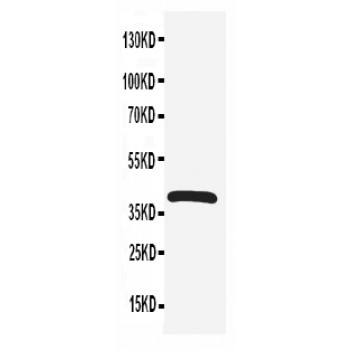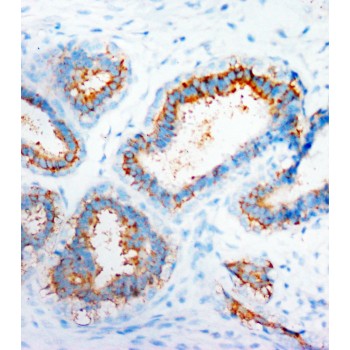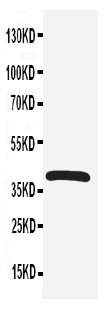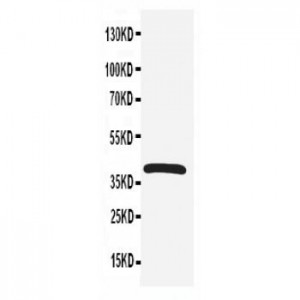More info
Overview
Long Name | Antibody Type | Antibody Isotype | Host | Species Reactivity | Validated Applications | Purification |
| chemokine(C-X-C motif) receptor 4 | Polyclonal | IgG | Rabbit | Human, Mouse, Rat | IHC-P, WB | Immunogen affinity purified. |
Immunogen | ||||||
| A synthetic peptide corresponding to a sequence at the N-terminus of human CXCR4(18-33aa SGDYDSMKEPCFREEN), different from the related rat and mouse sequences by two amino acids. | ||||||
Properties
Form | Lyophilized |
Size | 100 µg/vial |
Contents | Antibody is lyophilized with 5 mg BSA, 0.9 mg NaCl, 0.2 mg Na2HPO4, 0.05 mg Thimerosal and 0.05 mg NaN3. *carrier free antibody available upon request. |
Concentration | Reconstitute with 0.2 mL sterile dH2O (500 µg/ml final concentration). |
Storage | At -20 °C for 12 months, as supplied. Store reconstituted antibody at 2-8 °C for one month. For long-term storage, aliquot and store at -20 °C. Avoid repeated freezing and thawing. |
Additional Information Regarding the Antigen
Gene | CXCR4 |
Protein | C-X-C chemokine receptor type 4(CXC-R4/CXCR-4) |
Uniprot ID | P61073 |
Function | Receptor for the C-X-C chemokine CXCL12/SDF-1 that transduces a signal by increasing intracellular calcium ion levels and enhancing MAPK1/MAPK3 activation. Acts as a receptor for extracellular ubiquitin; leading to enhanced intracellular calcium ions and reduced cellular cAMP levels. Involved in hematopoiesis and in cardiac ventricular septum formation. Also plays an essential role in vascularization of the gastrointestinal tract, probably by regulating vascular branching and/or remodeling processes in endothelial cells. Involved in cerebellar development. In the CNS, could mediate hippocampal-neuron survival. Acts as a coreceptor (CD4 being the primary receptor) for HIV-1 X4 isolates and as a primary receptor for some HIV-2 isolates. Promotes Env-mediated fusion of the virus. Binds bacterial lipopolysaccharide (LPS) et mediates LPS-induced inflammatory response, including TNF secretion by monocytes. |
Tissue Specificity | Expressed in numerous tissues, such as peripheral blood leukocytes, spleen, thymus, spinal cord, heart, placenta, lung, liver, skeletal muscle, kidney, pancreas, cerebellum, cerebral cortex and medulla (in microglia as well as in astrocytes), brain microvascular, coronary artery and umbilical cord endothelial cells. Isoform 1 is predominant in all tissues tested. |
Sub-cellular localization | Cell membrane; Multi-pass membrane protein. Cell junction. Early endosome. Late endosome. Lysosome. Note: In unstimulated cells, diffuse pattern on plasma membrane. On agonist stimulation, colocalizes with ITCH at the plasma membrane where it becomes ubiquitinated. In the presence of antigen, distributes to the immunological synapse forming at the T-cell-APC contact area, where it localizes at the peripheral and distal supramolecular activation cluster (SMAC). |
Sequence Similarities | Belongs to the G-protein coupled receptor 1 family. |
Aliases | C-X-C chemokine receptor type 4 antibody|CD184 antibody|CD184 antigen antibody|Chemokine(C X C motif) receptor 4 antibody|Chemokine CXC Motif Receptor 4 antibody|CXC-R4 antibody|CXCR-4 antibody|CXCR4 antibody|CXCR4_HUMAN antibody|D2S201E antibody|FB22 antibody|Fusin antibody|HM89 antibody|HSY3RR antibody|LAP 3 antibody|LAP3 antibody|LCR1 antibody|LESTR antibody|Leukocyte derived seven transmembrane domain receptor antibody|Leukocyte-derived seven transmembrane domain receptor antibody|Lipopolysaccharide associated protein 3 antibody|Neuropeptide Y receptor Y3 antibody|NPY3R antibody|NPYR antibody|NPYRL antibody|NPYY3 antibody|NPYY3R antibody|Probable G protein coupled receptor lcr1 homolog antibody|SDF 1 receptor antibody|SDF-1 receptor antibody|SEVEN-TRANSMEMBRANE-SEGMENT RECEPTOR antibody|Stromal cell derived factor 1 receptor antibody|Stromal cell-derived factor 1 receptor antibody|WHIM antibody |
Application Details
| Application | Concentration* | Species | Validated Using** |
| Western blot | 0.1-0.5μg/ml | Human, Rat Mouse | AssaySolutio's ECL kit |
| Immunohistochemistry(Paraffin-embedded Section) | 0.5-1μg/ml | Human Mouse | AssaySolutio's IHC/ICC Detection kit |
AssaySolution recommends Rabbit Chemiluminescent WB Detection Kit (AKIT001B) for Western blot, and Rabbit Peroxidase IHC/ICC Detection Kit (AKIT002B) for IHC(P). *Blocking peptide can be purchased at $65. Contact us for more information

Anti-CXCR4 antibody, ASA-B0523, Western blotting
WB: HELA Cell Lysate
WB: HELA Cell Lysate

Anti-CXCR4 antibody, ASA-B0523, IHC(P)
IHC(P): Human Mammary Cancer Tissue
IHC(P): Human Mammary Cancer Tissue



